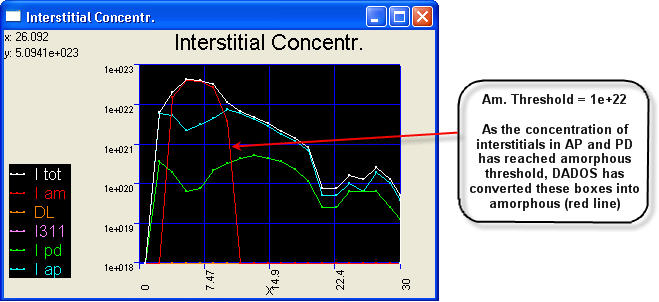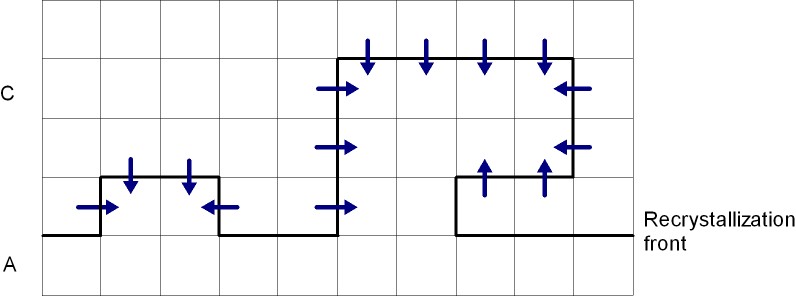DADOS uses AmorphizationThreshold to change the box state into amorphous. In this state, DADOS only counts the number of particles instead of store full data.

Amorphous boxes properties:
When an interstitial or vacancy comes into an amorphous region, it is deleted. DADOS only counts the amount (basically, the difference, I-V).
Impurities coming into an amorphous region are also deleted.
When a concentration is higher than MaxIVStorage, DADOS will only count the number of particles instead of store full data. With this algorithm, a lot of memory can be saved and the computerization needs cut down drastically.
DADOS converts into amorphous a region whose size is smaller than the value indicated by LatticeCollapse_nm3 if it is surrounded by an amorphous structure. Sometimes, a box should become amorphous but there are not enough particles and it does not. This could also be an important drawback as this non amorphous regions would be an important source of errors in recrystallization processes.
In order to prevent from physically incorrect effects, DADOS also smoothes amorphous regions with sizes higher than LatticeCollapse_nm3 by homogeneously distributing the concentrations.
Information about these parameters can be found in the messages window at the beginning of a simulation:

Recrystallization occurs at high temperature and only in the amorphous-crystalline interfaces, according to research, following a direction called "recrystallization front", towards the amorphous side.
The velocity of recrystallization is defined by means of an Arrhenius plot:

Where:
The number of interstitials and vacancies in an amorphous box which is going to recrystallize do not have to be the same. Thus, the box will have extra interstitials or vacancies. DADOS will transfer these particles into the next amorphous box, following the direction indicated by the recrystallization front (see figure below). If this front finds a surface, interstitials and vacancies will be eliminated there. If not, they will form clusters that, after annealing will evolve towards extended defects.

In an amorphous box which is going to recrystallize, there can be impurities. These ones can stay in the box as substitutional structures or be transferred into the next amorphous box following the direction indicated by the recrystallization front. In order to choose what to do, DADOS uses a probability, recrysDepositProb_?. But the maximum number of impurities particles that can be deposited in the box is limited by recrysMaxActive_?. The excess is deposited as complexes, with a maximum number of impurities in them defined by maxDepositedCxSize_?.